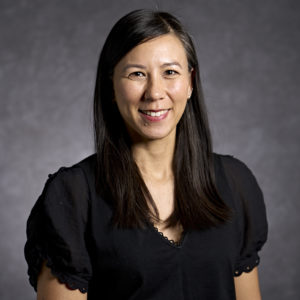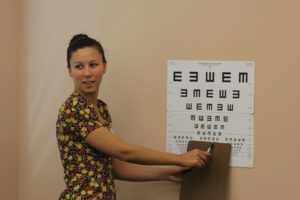December 15, 2022
By Charissa Young, OD, FAAO, FSLS
I knew when I became an optometrist that myopia management would be a dominant force in my practice, from lecturing on the topic to educating parents and treating myopic patients. I provided low-dose atropine, multifocal contact lenses, and orthokeratology as myopia management treatments on day one of seeing patients.
As a high myope, optometry has been a big part of my life since my first pair of glasses at seven years old. It wasn’t until my early 20s, at my annual eye examination, that I connected with my optometrist Dr. Patty Feiten in Seattle, Washington, and asked her more about her profession. Her excitement and passion for eye care inspired me to work with Dr. Summy To at an innovative and modern private practice in Portland, Oregon. I worked at Myoptic Optometry for two years while applying for optometry school, and it was a life-changing work experience. It was a cold-start practice, so I was fortunate to help support Dr. To in many roles, learning the ins and outs of the front desk, gaining opticianry skills, and providing medical technician support.
After graduating from optometry school in 2015, my role at Myoptic evolved. I moonlit on weekends, driving three hours between Portland and Seattle while doing a one-year fellowship in contact lenses and dry eye. Then, I transitioned to becoming an associate at Puget Sound Eye Care and worked there for five years, expanding their myopia management program.
Getting Involved with Myopia Management
I remember learning about myopia management for the first time during my first year of optometry school and feeling overwhelmed with regret — but I also saw a call to action. I was disappointed my high myopia wasn’t more proactively managed at its onset, though in the early ‘90s, myopia management was still in the early stages of our understanding; Professor Earl Smith and other researchers were starting to publish their findings on understanding myopia development using animal models.
I saw this as an opportunity to leave no myopic child behind. I knew when I became an optometrist that myopia management would be a dominant force in my practice, from lecturing on the topic to educating parents and treating myopic patients. I provided low-dose atropine, multifocal contact lenses, and orthokeratology as myopia management treatments on day one of seeing patients. I’ve always provided all available myopia management treatments and quickly implement new ones as they become available. In practice, orthokeratology was my initial go-to because of the dual impact of successful myopia management and the “wow” factor that comes with freedom from daytime correction.
I was fortunate during my fellowship that the practice I was working at had already implemented a myopia management program, which gave me the knowledge of how to create one at any practice I joined in the future. My current practice was primarily using atropine therapy as their main myopia management treatment, but my skills helped expand their program to also include multifocal contact lenses and orthokeratology. Expanding the treatment offerings was critical, as many providers know low-dose atropine alone is not always the best option for patients. This allowed us to customize treatments better for the individual patient. I’ve evolved my practice to customize treatments to patients’ needs, so I consider all treatments equally.
While our myopia practice is constantly evolving, we currently offer low-dose atropine from a local compounding pharmacy, multifocal contact lenses from CooperVision (MiSight and Biofinity) and Visioneering Technologies Inc. (NaturalVue 1 Day), and OrthoK lenses from Euclid and Paragon (Emerald, Sapphire, and CRT). We were one of the first practices in our state to have access to MiSight 1 day contact lenses.
I researched local and national practice websites to learn about their myopia programs to help develop ours, including our financial agreement and informed consent forms. We also started providing myopia consultation visits to dedicate the additional time for parent and patient education before choosing a myopia management treatment plan together. Our forms also provide a link to an outside parent-friendly resource with updated information about myopia management.
Staying Educated on Myopia Management
I start educating parents about myopia management even before they become parents! Most people have never heard of myopia management, so I deem it a public service to educate all myopic adults, so they keep it on their radar. If they’re receptive or curious, I’ll print out our myopia consultation form that we give families at the consultation visit, which overviews myopia management and the available treatments.
While the long-term dream is myopia prevention, we don’t have treatments for that. However, it resonates strongly with patients to tell them to imagine if they had 50% less myopia (which is the average amount myopia is slowed when treated). I joke with myopic patients about the wonder it would be to wake up and see the time on the alarm clock without correction, and it’s a personal experience they all sympathize with. If myopia management is implemented at the onset of the disease, we could keep the next generation in the low myopia category. This also means that once they’re out of the high-risk eye development stage as adults, they can have some functional nearsightedness without correction. And, of course, slowing the progression of myopia comes with the additional benefit of lowering their risk for glaucoma, early-onset cataracts, myopic degeneration, etc.
This is the golden era of myopia management research. There are so many studies published each month it’s hard to keep up! I subscribe to multiple resources, such as Review of Myopia Management, to ensure I don’t miss anything. I also attend lectures by the leaders in the field when they speak at the American Academy of Optometry Meeting, Global Specialty Lens Symposium, and Vision by Design.
The Future of Myopia Management
Myopia management needs to be the standard of care. While it is in my practice, I think it needs to be for all eye care practitioners. Is every patient going to participate? No. And it does take the provider extra time and energy to educate patients, but it’s a patient’s right to know myopia management is an option. I know insurance coverage for these treatments is controversial, but I support anything that increases patient access to care and hope it’s in the future for myopia management. I’m also excited about new treatments on the horizon, especially for a novel spectacle option for children who may not be a good fit for the currently available treatments.
 |
Charissa Young, OD, FAAO, FSLS, is currently in private practice in Seattle, Washington, specializing in myopia management, keratoconus, and medically necessary contact lens fittings. She graduated with her Doctor of Optometry degree from Pacific University College of Optometry and completed a post-doc one-year fellowship in specialty contact lenses and dry eye. As a high myope herself, she’s dedicated to educating and treating the next generation of myopes.
|














